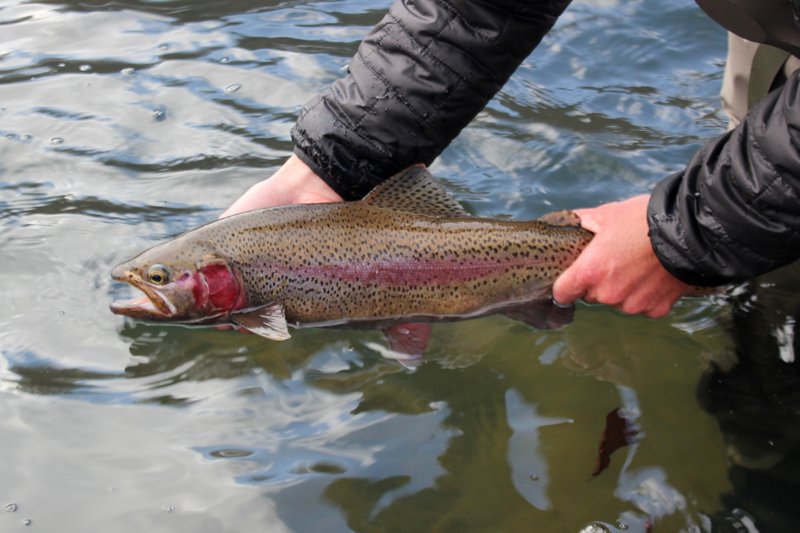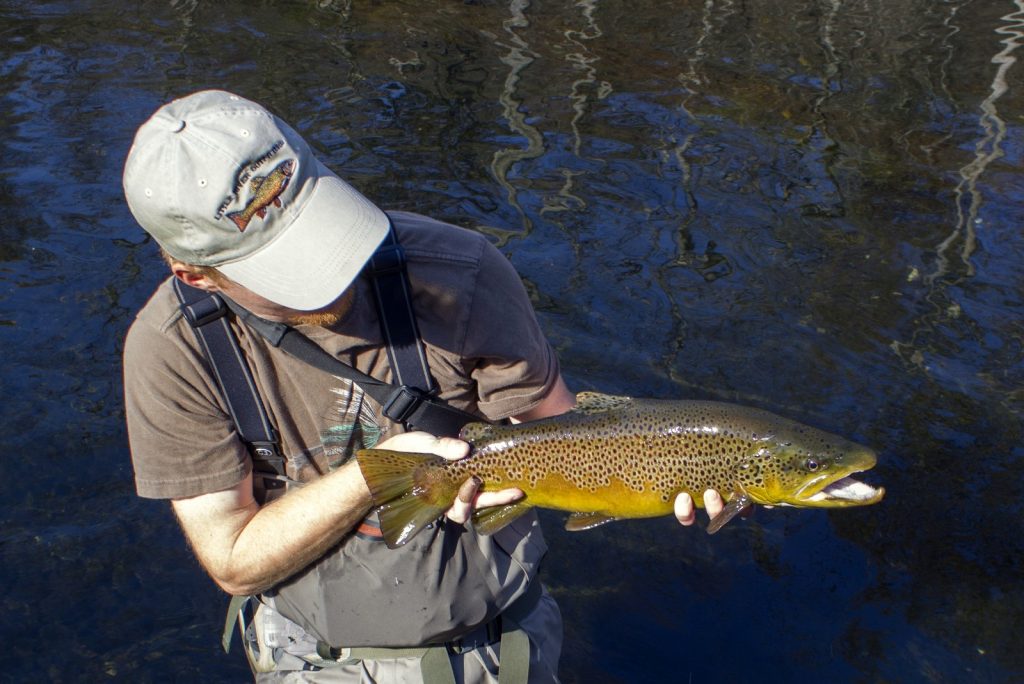The Clinch River is one of the very best rivers in the entire eastern United States. Ideally situated, the Clinch provides the perfect fly fishing excursion for anglers visiting the greater Knoxville, Tennessee area. Large rainbow trout and brown trout thrive in the cold water coming from Norris Dam. From time to time, the river also receives stockings of brook trout. The Clinch River is Tennessee’s oldest trout tailwater. The river flows from the base of 265 foot high Norris Dam. The extremely deep lake is what keeps the water cold that flows from the base of the dam.
Anglers looking to fly fish on the Clinch would do well to use a Clinch River fly fishing guide for their first time. This is because the trout have a reputation for being difficult. A guide will help unlock the secrets of this fantastic fishery.

Finding Clinch River Trout
Much of the Clinch River features large ledges alternating with long slow pools. Finding trout around the riffles and ledges is easy. However, finding trout in the slow water can be more challenging. Start by looking for subtle depth changes. Drop offs are not limited to the ledges and also happen in the middle of seemingly featureless flats and pools. Of course, as with most trout water, structure is everything.
On Tennessee tailwaters, structure is sometimes obvious, but it can also be very subtle. For example, on the Clinch, structure could be a change in bottom color. Edges of underwater grass or weed beds are also good holding areas. Another excellent habitat on the Clinch is riffle water. On the Clinch more than many other rivers, riffles hold ridiculous numbers of trout. Sometimes you have to get your fly in exactly the right spot, but if you do, then you will be catching fish after fish from seemingly the exact same spot.
As with most places, one particularly important rule on the Clinch River is that the harder the access, the better the fishing. If you are willing to walk farther than other anglers, you will probably find more willing trout.
Matching the Hatch: The Basics
As with most area tailwaters, the Clinch River is a midge fishery first and foremost. Anglers who catch the most fish on this river are generally fishing some type of midge larva or pupa. However, the Clinch is special because it also features a good to occasionally extraordinary sulfur hatch. The hatch generally starts in May. In good years, the bugs might come off through much of the summer. More typically the hatch peaks in late May or June before tapering off.
Day in and day out, you will catch more fish subsurface. Try nymphing with midge patterns #18 and smaller. Sulfur nymphs in #16 and #18 are good as well. When in doubt, a small Pheasant Tail nymph imitates the sulfurs reasonably well.
There are also a variety of caddis on the Clinch. Tan and little black caddis often hatch in the spring. These also hatch from time to time throughout the year so always be prepared. As with any tailwater, hatches can seemingly happen off schedule without warning.
The Clinch River often fishes best right in the middle of the day. This is probably because the sun’s energy warms the frigid tailwater just enough to get bugs going. There often seems to be a decided down turn in activity by mid to late afternoon. Pods of fish may transition to feeding on emerger or adult midges at this time. These fish require very long, fine leaders and tiny flies. The rewards can be worth the effort, however.
Matching the Hatch: Other Considerations
If you are wanting to target larger fish, then consider throwing larger flies. Streamer fishing on the Clinch can be phenomenal. Huge brown trout call the river home and are often willing to chase oversized streamers. Big rainbows also like to eat meat. Even wading anglers sometimes catch very large fish on flies like an olive Wooly Bugger.

Hopper and beetle fishing can be good at times on the Clinch River. Don’t overlook having a few in your box, especially in mid to late summer. Inch worms and ants can also be locally important under overhanging trees. Don’t forget to have a few worm patterns as well. These are deadly after a heavy rainfall because the extra water washes them into the river.
Sight Fishing
One of the best things about the Clinch River and most other Tennessee tailwaters is the excellent sight fishing opportunities. The Clinch runs extremely clear year round. The only exception is that much of the river can muddy after heavy rains. Coal Creek just above the I-75 bridge is the source for most of this muddy water.
The rest of the time, the Clinch offers anglers the challenge of finding, stalking, and ultimately catching trophy trout. This is even tougher because of the small flies required, however it is probably some of my very favorite fishing anywhere. When you think of the pinnacle of fly fishing, it probably involves sight fishing in some form. The Clinch offers good subsurface and surface sight fishing opportunities.
Releasing Your Catch
Even when regulations allow, we strongly advocate for catch and release angling, because we are much more interested in catching large numbers of big fish instead of only a few small trout. The fish cannot grow into large fish if they are harvested. Tailwaters like the Clinch River are capable of growing many large trout ranging from 16 to 28 or 30 inches in length, but the fish won’t grow out of the water. Please release your catch and contribute towards better angling opportunities in the future.
Other Game Fish
The Clinch River features many other game fish. White bass on the lower river and stripers at least up to the Interstate 75 bridge are some of the most obvious. Don’t overlook the possibility of musky in the lower river, particularly in the upper end of Melton Hill Reservoir. That said, trout are the main draw here and rightfully so. If you do want to chase striped bass, fish for them on high water with large streamers and heavy fly rods out of a boat.
Guided Fly Fishing on the Clinch River
We offer guided fly fishing trips to suit any angler. From beginners to expert anglers, our wade or float trips can be tailored to any needs. Our boat is a beautiful 2019 ClackaCraft Eddy. This allows us to cover much of the river that is not accessible to wading anglers. That said, if your main goal is to learn the river so you can fish it on your own, then a wade trip might be in order.
Most anglers end up coming back again and again for our Clinch River float trips. The scenery and many trout the river offers is enough to satisfy any angler. We can also accommodate group trips and occasionally offer tailwater classes. Please contact me if you are interested in one of the classes.
Where to Fly Fish on the Clinch River
The Clinch River offers most access on the upper river in the first few miles below Norris Dam. Millers Island is probably the most popular, but the long flat water above the weir dam or the riffles below are also popular. The jail/church access in Clinton just above the highway 61 bridge also provides access to a good amount of water. In this stretch, we prefer walking well upstream before starting to fish. Before going, always check the river flows through TVA.
